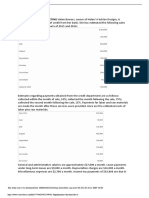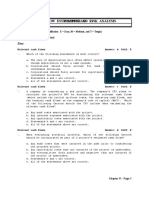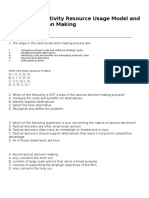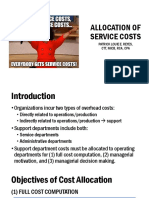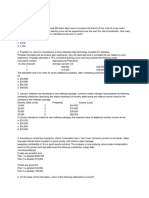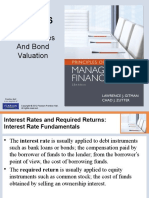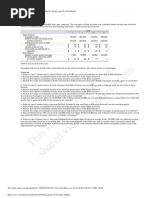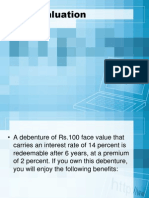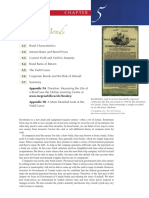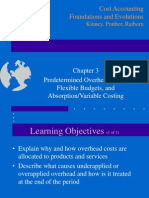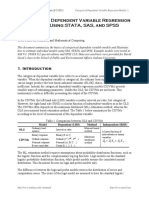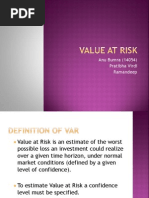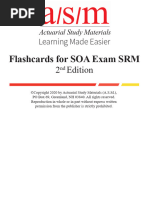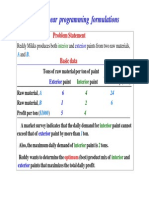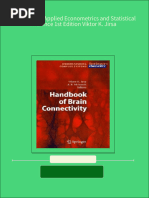0 ratings0% found this document useful (0 votes)
363 viewsTime Value of Money
Time Value of Money
Uploaded by
Catalan MelodyCopyright:
© All Rights Reserved
Available Formats
Download as PPTX, PDF, TXT or read online from Scribd
Time Value of Money
Time Value of Money
Uploaded by
Catalan Melody0 ratings0% found this document useful (0 votes)
363 views42 pagesOriginal Title
time-value-of-money (1)
Copyright
© © All Rights Reserved
Available Formats
PPTX, PDF, TXT or read online from Scribd
Share this document
Did you find this document useful?
Is this content inappropriate?
Copyright:
© All Rights Reserved
Available Formats
Download as PPTX, PDF, TXT or read online from Scribd
Download as pptx, pdf, or txt
0 ratings0% found this document useful (0 votes)
363 views42 pagesTime Value of Money
Time Value of Money
Uploaded by
Catalan MelodyCopyright:
© All Rights Reserved
Available Formats
Download as PPTX, PDF, TXT or read online from Scribd
Download as pptx, pdf, or txt
You are on page 1of 42
At a glance
Powered by AI
The key takeaways are the concepts of time value of money, future value, present value, compound interest and discounting cash flows.
The three basic patterns of cash flows are single amounts, annuities, and mixed streams.
Future value uses compounding to calculate the value of cash flows in the future, while present value uses discounting to calculate the value of cash flows today.
Chapter 5: Time Value of Money
Principles of Managerial Finance by
Gitman and Zutter
Future Value vs. Present Value
• Time line – a horizontal line on which time
zero appears at the leftmost end and future
periods are marked from left to right; can be
used to depict investment cash flows.
• Note to the teacher: illustrate timeline with
compounding and discounting
Future Value vs. Present Value cont
• The future value technique uses
compounding to find the future value of each
cash flow at the end of the investment’s life
and then sums these values to find the
investment’s future value.
• The present value technique uses discounting
the find the present value of each cash flow at
time zero and then sums these values to find
the investment’s value today.
Basic Patterns of Cash Flow
• 1. Single amount – a lump-sum amount either
currently held or expected at some future
date.
• 2. Annuity – a level periodic stream of cash
flow.
• 3. Mixed stream – a stream of cash flow that is
not an annuity; a stream of unequal periodic
cash flows that reflect no particular pattern.
Single Amounts – Future Value
• Future value – is the value at a given future
date of an amount placed on deposit today
and earning interest at a specified rate.
• Compound interest – interest that is earned
on a given deposit and has become part of the
principal at the end of a specified period.
• Principal – the amount of money on which
interest is paid.
Single Amounts – Future Value
• The future value depends on the interest rate
and the number of periods that money is
invested.
• The higher the interest rate, the higher the
future value
• The longer the period of time, the higher the
future value.
Single Amounts - Present Value
• Present value – the current peso value of a future
amount – the amount of money that would have
to be invested today at a given interest rate over
a specified period to equal the future amount.
• Discounting cash flows – the process of finding
present values;
• The inverse of compounding interest.
Single Amounts - Present Value cont
• Instead of finding the future value of present
pesos invested at a given rate, discounting
determines the present value of a future
amount, assuming an opportunity to earn a
certain return on the money.
• This annual rate of return is variously referred
to as the discount rate, required rate, cost of
capital, and opportunity cost.
Single Amounts – Present Value
• The higher the discount rate, the lower the
present value
• The longer the period of time, the lower the
present value.
Annuities
• Annuity – a stream of equal periodic cash
flows over a specified time period.
• These cash flows can be inflows of returns
earned on investments or outflows of funds
invested to earn future returns.
Types of Annuities
• 1. Ordinary annuity – an annuity for which the
cash flow occurs at the end of each period.
• 2. Annuity due – an annuity for which the cash
flow occurs at the beginning of each period.
Ordinary Annuity vs. Annuity Due
• Ordinary Annuity
• Year annuity due
• 0 P0 P1,000
• 1 1,000 1,000
• 2 1,000 1,000
3 1,000 1,000
• 4 1,000 1,000
• 5 1,000 0
• ------- -------
• Totals P5,000 P5,000
Annuities
• The annuity due would have a higher future
value than the ordinary annuity because each
of its five annual cash flows can earn interest
for 1 year more than each of the ordinary
annuity’s cash flows.
• In general, the value (present or future) of an
annuity due is always greater than the value
of an otherwise identical ordinary annuity.
Comparison of Annuity Due with
Ordinary Annuity Future Value cont
• Because the cash flow of the annuity due
occurs at the beginning of the period rather
than at the end (that is, each payment comes
one year sooner in the annuity due), its future
value is greater.
Finding the Present Value of a
Perpetuity
• Perpetuity – an annuity with an infinite life –
in other words, an annuity that never stops
providing its holder with a cash flow at the
end of each year.
Example
• Ross Clark wishes to endow a chair in finance
at his alma mater. The university indicated
that it requires P200,000 per year to support
the chair, and the endowment would earn
10% per year.
• PV = P200,000 / 10% = P2,000,000
Mixed Streams
• Mixed stream – a stream of unequal periodic
cash flows that reflect no particular pattern.
Future Value of a mixed Stream
• We determine the future value of each cash
flow at the specified future date and then add
all the individual future values to find the total
future value.
Present Value of a Mixed Stream
• We determine the present value of each
future amount and then add all the individual
present values together to find the total
present value.
Compounding Interest More
Frequently than Annually
• Semiannual compounding – compounding of
interest over two periods within the year.
• Quarterly compounding – compounding of
interest over four periods within the year.
• The more frequently interest is compounded,
the greater the amount of money
accumulated. This is true for any interest rate
for any period of time.
Continuous Compounding
• Continuous compounding – compounding of
interest an infinite number of times per year
at intervals of microseconds.
Example
• Present value = P100
• Annual rate of interest, compounded
• continuously = 8%
• Number of years = 2
• Note to teacher: use Excel,
• =b2*exp(b3*b4)
Nominal and Effective Annual Rates
(EAR) of Interest
• Nominal (stated) annual rate – contractual
annual rate of interest charged by a lender or
promised by a borrower.
• Effective (true) annual rate (EAR) – the annual
rate of interest actually paid or earned.
EAR cont
• 2 points:
• 1. Nominal and effective annual rates are
equivalent for annual compounding.
• 2. The effective annual rate increases with
increasing compounding frequency.
APR vs APY
• Annual percentage rate (APR) – the nominal
annual rate of interest, found by multiplying the
periodic rate by the number of periods in one
year, that must be disclosed to consumers on
credit cards and loans as a result of “truth-in-
lending” laws.
• Annual percentage yield (APY) – the effective
annual rate of interest that must be disclosed to
consumers by banks on their savings products as
a result of “truth-in-savings laws”.
Special Applications of Time Value
• 1. Determining deposits needed to
accumulate a future sum
• 2. Loan amortization – the determination of
the equal periodic loan payments necessary to
provide a lender with a specified interest
return and to repay the loan principal over a
specified period.
• 3. Finding interest or growth rates
• 4. Finding an unknown number of periods
Loan Amortization
• Loan amortization schedule – a schedule of
equal payments to repay a loan. It shows the
allocation of each loan payment to interest
and principal.
ST5-1
• Delia Martin has P10,000 that she can deposit in
any of three savings accounts for a 3-year period.
Bank A compounds interest on an annual basis,
Bank B compounds interest twice each year, and
Bank C compounds interest each quarter. All
three banks have a stated annual interest rate of
4%.
ST5-1 cont
• A. what amount would Ms. Martin have at the end of the
third year, leaving all interest paid on deposit, in each
bank?
• B. what effective annual rate (EAR) would she earn in each
of the banks?
• C. On the basis of your findings in parts A and B, which
bank should Ms. Martin deal with? Why?
• D. If a fourth bank (Bank D), also with a 4% stated interest
rate, compounds interest continuously, how much would
Ms. Martin have at the end of the third year? Does this
alternative change your recommendations in part C?
Explain why for why not.
ST5-2
• Ramesh Abdul wishes to choose the better of two
equally costly cash flow streams: annuity X and
annuity Y. X is an annuity due with a cash inflow of
P9,000 for each of 6 years. Y is an ordinary
annuity with a cash inflow of P10,000 for each of
6 years. Assume that Ramesh can earn 15% on his
investments.
ST5-2 cont
• A. On a purely subjective basis, which annuity
do you think is more attractive?
• B. Find the future value at the end of year 6
for both annuities.
• C. Use your finding in part B to indicate which
annuity is more attractive. Why? Compare
your finding to your subjective response in
part A.
ST5-3
• You have a choice of accepting either of two 5-
year cash flow streams or single amounts. One
cash flow stream is an ordinary annuity, and the
other is a mixed stream. You may accept
alternative A or B – either as a cash flow stream
or as a single amount. Given the cash flow
stream and single amounts associated with each
, and assuming a 9% opportunity cost, which
alternative (A or B) and in which form (cash flow
stream or single amount) would you prefer?
ST5-3 cont
• Cash flow stream
• End of year Alternative A Alternative B
• 1 P700 P1,100
• 2 700 900
• 3 700 700
• 4 700 500
• 5 700 300
• Single amount
• At time zero P2,825 P2,800
ST5-4
• Judi Janson wishes to accumulate P8,000 by
the end of 5 years by making equal, annual,
end-of-year deposits over the next 5 years. If
Judi can earn 7% on her investments, how
much must she deposit at the end of each
year to meet this goal?
4-1
• If you deposit $10,000 in a bank account that
pays 10% interest annually, how much will be
in your account after 5 years?
4-2
• What is the present value of a security that
will pay $5,000 in 20 years if securities of
equal risk pay 7% annually?
4-3
• Your parents will retire in 18 years. They
currently have $250,000, and they think they
will need $1 million at retirement. What
annual interest rate must they earn to reach
their goal, assuming they don’t save any
additional funds?
4-4
• If you deposit money today in an account that
pays 6.5% annual interest, how long will it
take to double your money?
4-6
• What is the future value of a 7%, 5-year
ordinary annuity that pays $300 each year? If
this were an annuity due, what would its
future value be?
4-7
• An investment will pay $100 at the end of
each of the next 3 years, $200 at the end of
Year 4, $300 at the end ofYear 5, and $500
atthe end of Year 6. If otherinvestments of
equal risk earn 8% annually, what is this
investment’s present value? Its future value?
End of chapter 5
You might also like
- Chapter 14Document38 pagesChapter 14Ngoc Nguyen100% (1)
- Chapter 13 SolutionDocument26 pagesChapter 13 SolutionSunil Sharma100% (1)
- Quiz 1 1203 ACYAVA1 K32 ADVANCED FINANCIAL ACCOUNTING AND REPORTING 1 PDFDocument33 pagesQuiz 1 1203 ACYAVA1 K32 ADVANCED FINANCIAL ACCOUNTING AND REPORTING 1 PDFSittie Ainna Acmed UnteNo ratings yet
- Introduction To Fixed-Income Valuation - 1: Question #1 of 70Document23 pagesIntroduction To Fixed-Income Valuation - 1: Question #1 of 70Michael OlsonNo ratings yet
- Screening and Selecting Capital Investment ProposalsDocument12 pagesScreening and Selecting Capital Investment ProposalsVince BesarioNo ratings yet
- Increased Revenues $10,000 $120,000 Increased Expenses: 14,000 Salary of Additional Operator Supplies Depreciation 12,000 Maintenance 8,000 90,000 Increased Net Income $30,000Document98 pagesIncreased Revenues $10,000 $120,000 Increased Expenses: 14,000 Salary of Additional Operator Supplies Depreciation 12,000 Maintenance 8,000 90,000 Increased Net Income $30,000Navindra JaggernauthNo ratings yet
- Chapter 1 - SOLUTIONSDocument12 pagesChapter 1 - SOLUTIONSGeorge GregoriouNo ratings yet
- FINMA Bond Valuation AssignmentDocument2 pagesFINMA Bond Valuation AssignmentMarian Augelio Polanco100% (1)
- 16-10 CASH BUDGETING Helen Bowers, Owner of Helen's Fashion Designs, IsDocument4 pages16-10 CASH BUDGETING Helen Bowers, Owner of Helen's Fashion Designs, IsJarold MatiasNo ratings yet
- Problem Set-Leverage and Capital StructureDocument10 pagesProblem Set-Leverage and Capital StructuremaazNo ratings yet
- Madura Chapter 3 PDFDocument37 pagesMadura Chapter 3 PDFMahmoud AbdullahNo ratings yet
- Capital BudgetingDocument14 pagesCapital BudgetingSuraj OzardeNo ratings yet
- Working Capital and Current Assest ManagementDocument84 pagesWorking Capital and Current Assest Managementbusi.kg.tshNo ratings yet
- Cash Flow Estimation BrighamDocument77 pagesCash Flow Estimation BrighamDianne GalarosaNo ratings yet
- Fsy Tutorial 5Document4 pagesFsy Tutorial 5TACN-4TC-19ACN Nguyen Thu HienNo ratings yet
- Chapter 4 Time Value of Money SolutionsDocument29 pagesChapter 4 Time Value of Money SolutionsLe ThuanNo ratings yet
- Stock Shares Price ($) Market Value of AssetsDocument34 pagesStock Shares Price ($) Market Value of AssetsRADHIKA BANSALNo ratings yet
- Finac 2Document18 pagesFinac 2annewilsonNo ratings yet
- Appendix GDocument3 pagesAppendix GYardie TreyBwoy100% (1)
- (6-2) Interest Rate Levels CH Answer: B MEDIUMDocument9 pages(6-2) Interest Rate Levels CH Answer: B MEDIUMMohsin2k100% (1)
- The Basics of Capital BudgetingDocument56 pagesThe Basics of Capital BudgetingRanin, Manilac Melissa SNo ratings yet
- Capital Budgeting: Test Code: R35 CABU Q-BankDocument7 pagesCapital Budgeting: Test Code: R35 CABU Q-BankMarwa Abd-ElmeguidNo ratings yet
- Leases With Answers Freudenthal 100Document14 pagesLeases With Answers Freudenthal 100Julie BagaresNo ratings yet
- MSQ 08 Capital BudgetingDocument15 pagesMSQ 08 Capital Budgetingbaltazarjosh806No ratings yet
- Fs AnalysisDocument83 pagesFs Analysismarjorie kimNo ratings yet
- Chapter 9 Ed 16Document73 pagesChapter 9 Ed 16Ivhy Cruz Estrella100% (1)
- Allocation of Service Costs: Patrick Louie E. Reyes, CTT, Micb, Rca, CpaDocument22 pagesAllocation of Service Costs: Patrick Louie E. Reyes, CTT, Micb, Rca, CpaClaudette ClementeNo ratings yet
- Use Capital Letters Only Label Answers Properly Answers Must Be Handwritten Present Solutions. Submit Answers Through Messenger or EmailDocument6 pagesUse Capital Letters Only Label Answers Properly Answers Must Be Handwritten Present Solutions. Submit Answers Through Messenger or EmailJungie Mablay WalacNo ratings yet
- Intermediate Accounting Exam 2Document1 pageIntermediate Accounting Exam 2BLACKPINKLisaRoseJisooJennieNo ratings yet
- PFM15e IM CH05Document33 pagesPFM15e IM CH05Daniel HakimNo ratings yet
- Ms09 Standard Costing Variance AnalysisDocument7 pagesMs09 Standard Costing Variance AnalysisAshley BrevaNo ratings yet
- Acc 115 P1quiz - ADocument7 pagesAcc 115 P1quiz - AShei EngaranNo ratings yet
- Chapter 11 - Audit Sampling Concepts - NotesDocument9 pagesChapter 11 - Audit Sampling Concepts - NotesSavy DhillonNo ratings yet
- Capital Market Line (Rohit)Document33 pagesCapital Market Line (Rohit)agrawalrohit_228384No ratings yet
- Manual 16 Jun 2021 - Part 1Document6 pagesManual 16 Jun 2021 - Part 1Feni AlvitaNo ratings yet
- Chapter 06 GitmanDocument38 pagesChapter 06 GitmanLBL_LowkeeNo ratings yet
- Midterm Exam FinmanDocument5 pagesMidterm Exam FinmanAnaluz Cristine B. CeaNo ratings yet
- Ma2 Project Screening Projec Ranking and Capital RationingDocument11 pagesMa2 Project Screening Projec Ranking and Capital RationingMangoStarr Aibelle Vegas100% (1)
- Chapter 20 - Hybrid Financing - Prefernce Shares, Leasing, Options, Warrants, & ConvertiblesDocument2 pagesChapter 20 - Hybrid Financing - Prefernce Shares, Leasing, Options, Warrants, & Convertibleslou-924No ratings yet
- Managerial ACCT Quiz 259 PDFDocument4 pagesManagerial ACCT Quiz 259 PDFFerl ElardoNo ratings yet
- Bond Valuation: Anita RamanDocument35 pagesBond Valuation: Anita RamanTanmay MehtaNo ratings yet
- ACYASR2 Syllabus T1-AY2023-2024Document10 pagesACYASR2 Syllabus T1-AY2023-2024Janea Lorraine TanNo ratings yet
- Financial MANAGEMENT: (Vip Questions)Document39 pagesFinancial MANAGEMENT: (Vip Questions)Khalil AbdoNo ratings yet
- Wacc Practice 1Document3 pagesWacc Practice 1Ash LayNo ratings yet
- Risk and Return: Sample ProblemsDocument14 pagesRisk and Return: Sample ProblemsRynette FloresNo ratings yet
- Review of Accounting Cycle - w97Document17 pagesReview of Accounting Cycle - w97Ding CostaNo ratings yet
- 08 .1 Responsibility Accounting TBPDocument2 pages08 .1 Responsibility Accounting TBPMilani Joy LazoNo ratings yet
- Time Value of Money PracticeDocument11 pagesTime Value of Money PracticeUmer ArshadNo ratings yet
- Chapter 5 Valuing BondsDocument34 pagesChapter 5 Valuing BondsSamantha YuNo ratings yet
- 7.29.22 Am Trade-And-Other-ReceivablesDocument5 pages7.29.22 Am Trade-And-Other-ReceivablesAether SkywardNo ratings yet
- Fringe Benefit TaxDocument5 pagesFringe Benefit Taxricamae saladagaNo ratings yet
- Reviewer Borrowing Cost Sec. 1-10Document4 pagesReviewer Borrowing Cost Sec. 1-10imsana minatozakiNo ratings yet
- Bam 040 Managerial Economics Mock Phinma Exam Key AnswerDocument17 pagesBam 040 Managerial Economics Mock Phinma Exam Key AnswerdeawhenNo ratings yet
- Chapter 4 - Receivables ManagementDocument17 pagesChapter 4 - Receivables Managementbereket nigussieNo ratings yet
- Chapter 3 Predetermined FOH RatesDocument37 pagesChapter 3 Predetermined FOH RatesAtif SaeedNo ratings yet
- TB - Chapter08 Stocks and Their ValuationDocument80 pagesTB - Chapter08 Stocks and Their ValuationMarie Bernadette AranasNo ratings yet
- Maulana Ikhsan Tarigan (Financial Statement Analysis) 197007091Document11 pagesMaulana Ikhsan Tarigan (Financial Statement Analysis) 197007091Maulana IkhsanNo ratings yet
- Chapter Time Value of Money ExerciseDocument3 pagesChapter Time Value of Money ExerciseLưu Ngọc Tường ViNo ratings yet
- Chapter 3 - Time Value of Money-1Document21 pagesChapter 3 - Time Value of Money-1ayelelemmaNo ratings yet
- Basic Long-Term Financial Concepts.pptx 2Document73 pagesBasic Long-Term Financial Concepts.pptx 2Alizandra MyshelNo ratings yet
- Eg 441 Eng Econ 1Document19 pagesEg 441 Eng Econ 1David KalerNo ratings yet
- One Way AnovaDocument5 pagesOne Way AnovaJeff Rey Casiño DalubatanNo ratings yet
- 18.6501x Fundamentals of Statistics - Syllabus and Schedule: Week 1Document4 pages18.6501x Fundamentals of Statistics - Syllabus and Schedule: Week 1BenNo ratings yet
- Design of Experiments With Several Factors: Delivered To: CCIIDI, Ministry of IndustryDocument35 pagesDesign of Experiments With Several Factors: Delivered To: CCIIDI, Ministry of IndustrymesfinNo ratings yet
- Binomial Probability Formula 1Document4 pagesBinomial Probability Formula 1abel mahendraNo ratings yet
- Jurnal TitusDocument11 pagesJurnal TitusTitusBrahamSimamoraNo ratings yet
- ECON 440/640 Problem Set 4 AnswersDocument4 pagesECON 440/640 Problem Set 4 AnswersBharavi KothapalliNo ratings yet
- Categorical Dependent Variable Regression Models Using STATA, SAS, and SPSSDocument32 pagesCategorical Dependent Variable Regression Models Using STATA, SAS, and SPSSyuva rajNo ratings yet
- Pivot TableDocument52 pagesPivot TableJohn RobertNo ratings yet
- Col LinearityDocument14 pagesCol LinearityYosytha ParissingNo ratings yet
- Value at Risk FinalDocument27 pagesValue at Risk FinalAnu BumraNo ratings yet
- MSF 566 Topic 04 Modeling With VolatilityDocument36 pagesMSF 566 Topic 04 Modeling With VolatilitygallardoaniaNo ratings yet
- Chapter 9 - Simple Regression Analysis - L1 - Jan 2024Document26 pagesChapter 9 - Simple Regression Analysis - L1 - Jan 2024afiqmaniyaminNo ratings yet
- The MDC Procedure: Chapter ContentsDocument74 pagesThe MDC Procedure: Chapter Contentsaniruddha.iima100% (1)
- 45 Data Scientist QuestionsDocument53 pages45 Data Scientist QuestionsVipin ChughNo ratings yet
- A Second Course in Statistics Regression AnalysisDocument8 pagesA Second Course in Statistics Regression AnalysiscklgisaNo ratings yet
- SOA Exam SRM - ASM Learning FlashcardsDocument26 pagesSOA Exam SRM - ASM Learning Flashcardsmutiep.873No ratings yet
- Cola AnswersDocument3 pagesCola AnswersFatimaNo ratings yet
- Dual Simplex MethodDocument27 pagesDual Simplex MethodKirtibant Naha100% (2)
- Thesis With Regression AnalysisDocument7 pagesThesis With Regression Analysisxlyexqvff100% (2)
- Lecture 1 Linear Programming Formulations: Problem StatementDocument48 pagesLecture 1 Linear Programming Formulations: Problem StatementKatie CookNo ratings yet
- MBA 6324 Operations and Supply Chain Management: Betting On Uncertain Demand: The Newsvendor Model Chapter 12)Document31 pagesMBA 6324 Operations and Supply Chain Management: Betting On Uncertain Demand: The Newsvendor Model Chapter 12)masing4christNo ratings yet
- Spss 23 1. UJI VALIDITAS (Rhitung Rtabel ( (Analyze - Corralate - Bivariate - (Total Juga Dimasukan) X1Document10 pagesSpss 23 1. UJI VALIDITAS (Rhitung Rtabel ( (Analyze - Corralate - Bivariate - (Total Juga Dimasukan) X1alif faruqiNo ratings yet
- Product Limit EstimatorDocument18 pagesProduct Limit EstimatorjulyfriskaNo ratings yet
- Binomial 2Document67 pagesBinomial 2DamiàNo ratings yet
- Type I & Type II Errors With ExamplesDocument8 pagesType I & Type II Errors With ExamplesIshan JainNo ratings yet
- 6 & 7. Capm & AptDocument20 pages6 & 7. Capm & AptDicky Irawan100% (1)
- HRDocument9 pagesHRniranjanaNo ratings yet
- Handbook of Applied Econometrics and Statistical Inference 1st Edition Viktor K. JirsaDocument84 pagesHandbook of Applied Econometrics and Statistical Inference 1st Edition Viktor K. JirsaasmuyuoriNo ratings yet
- Mba 641 - Quantitative Analysis For Management DecisionsDocument4 pagesMba 641 - Quantitative Analysis For Management DecisionsDejen Tagelew100% (1)








